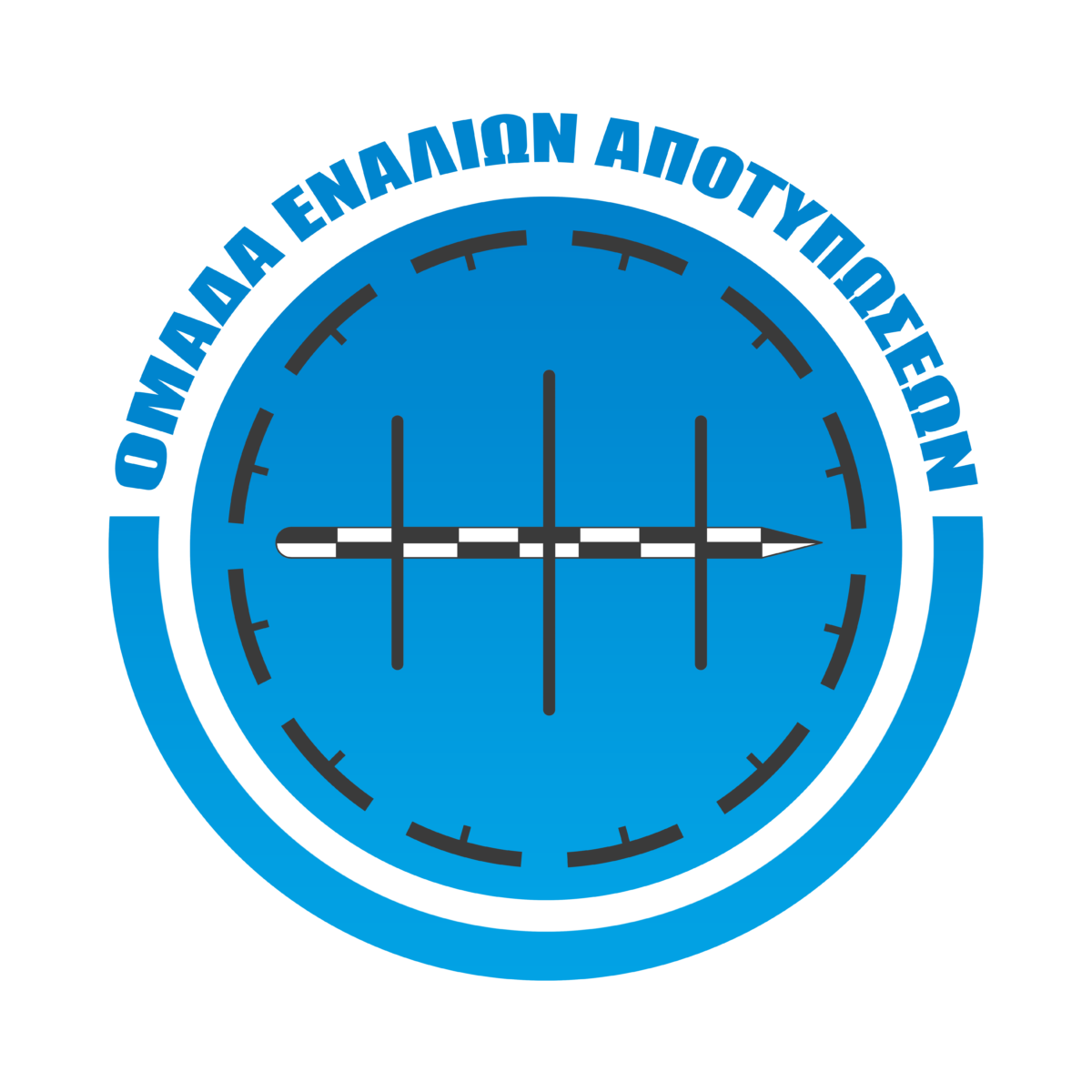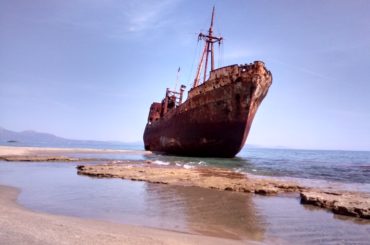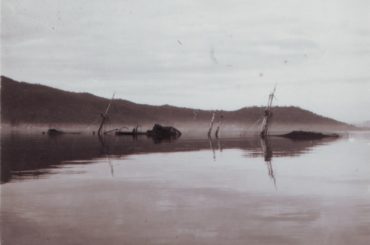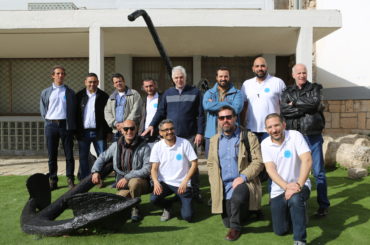This article appeared in Taxydromos newspaper on 13.10.2019 to mark the 75th Anniversary of the Liberation of Greece. October 1944 – October 2019
Friday the 13th, October 1944 began in the city of Volos much like any other. Starved and subjugated, its citizens managed as best they could under a merciless Nazi regime. The ‘Kítrino Apothíki’ on the corner of Vassani and Gazi Streets still stands as testimony to those dark days. Countless were incarcerated and tortured within its imposing grey walls. Far too many did not survive. After the abortive 1940 invasion by Italian fascists, it had taken just three weeks after crossing the Metaxas Line on 6th April 1941 for the Germans to successfully Blitzkrieg their way through the whole country. Volos had continued to languish under its oppressors since then.
However, by the autumn of 1944, the tides of war were seriously turning against Hitler. A string of defeats which included the loss of North Africa, the D-Day landings in Normandy and the successful Allied liberation of the Italian peninsula right up to the Gothic Line were making a mockery of the promised 1,000 year Reich. More worrying for the German occupiers was that targets in Yugoslavia and Albania were under constant air attack, thus clearing the Adriatic and causing havoc to supply lines to Greece. Importantly, the Red Army was fighting back the Germans on a front stretching from the Baltic to the Black Sea. By August 1944, they had ousted the Wehrmacht from Romania and absorbed the former Axis power into the growing Soviet territories. Bulgaria, which had annexed the Greek regions of eastern Macedonia and western Thrance for the Germans in 1941, would be next.
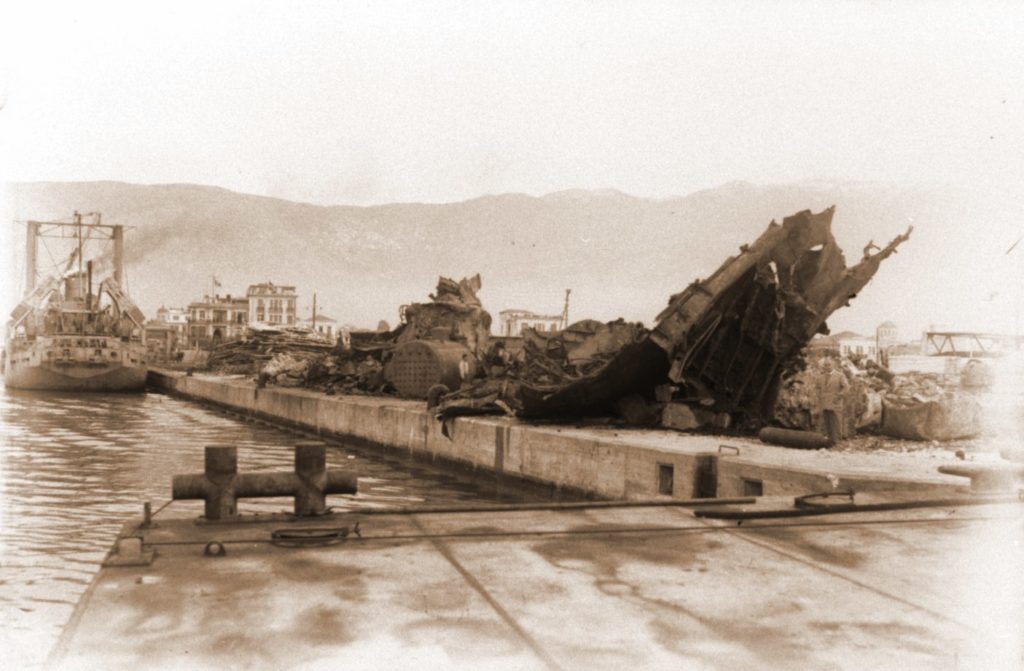
Post raid clean-up operations in Volos. The Kingarth, a vessel used extensively to remove the wrecks, can be seen on the left (a man standing in front of debris offers a sense of scale). Photo courtesy of Volos municipal Center for Historical Research and Documentation (www.diki.gr)
The growing threat of being cut-off from the Fatherland was a problem further compounded by other factors. Despite the previous year’s brutal but successful counter-operations undertaken by elite German troops against E.L.A.S. and E.D.E.S., these politically opposed Greek resistance groups remained a thorn in the oppressor’s side. Moreover, the Allies were using the ground gained in Italy to launch an ever increasing number of air sorties on German shipping and military targets in Greece.
Any elation felt by the citizens of Volos on learning that the Germans had finally evacuated Athens on October the 12th was to be short-lived. By the morning of the 13th, its harbour was brimming with vessels which had fled Piraeus two days earlier. The Allies soon became aware of this fact. One report confirms that “an unusual concentration of shipping was laying in the main harbour.” Volos had suddenly become a high-priority target.
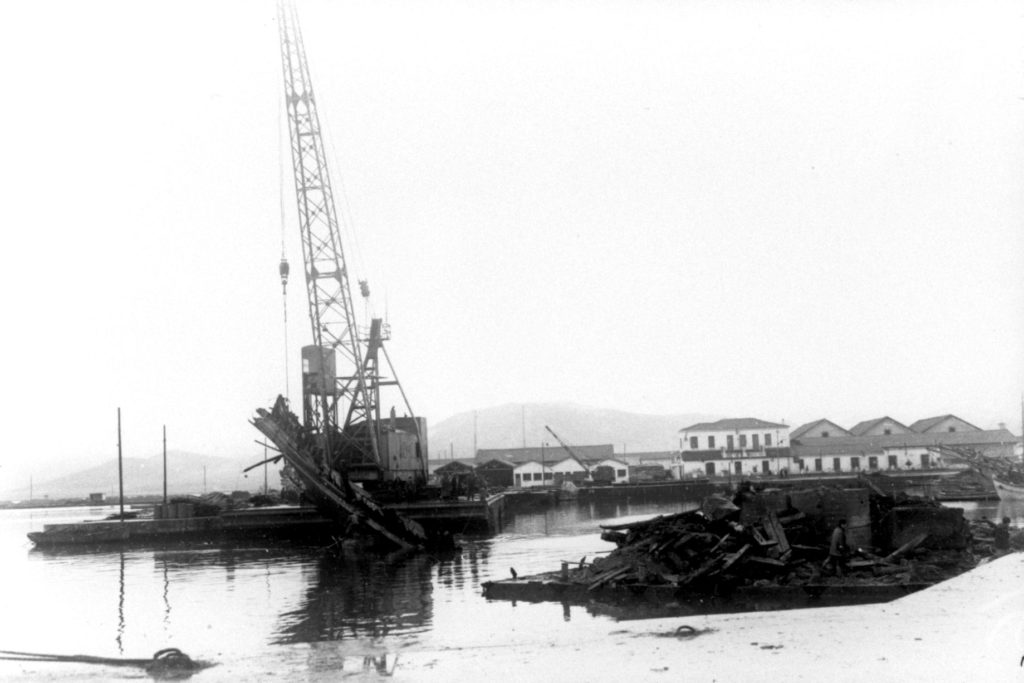
A crane mounted on a floating platform removes debris. The customs buildings in the background still exist. Photo courtesy of Volos municipal Center for Historical Research and Documentation (www.diki.gr)
Buried in the official archives for the last 75 years are the details of what happened next. Only by careful scrutiny and cross-referencing of the Allies’ declassified Top Secret War Dairies can the full story to be brought to light. The reward for this painstaking process is that new insights and twists to the tale can be substantiated.
As the citizens of Volos slept that Friday, final flight preparations for another mission over enemy territory were being made. Operation 54 was to be carried out by the 25th Squadron of the S.A.A.F. (South African Air Force). At 07.10 hrs, a flight of twelve Ventura bomber aircraft commanded by Lieutenant Colonel Shuttleworth took off from Biferno, Italy. Each carried a deadly payload of 2,500 Ibs (1,200 kg). At 08.30 hrs, the flight landed in Brindisi for refuelling and a final briefing. Unluckily, one of the aircraft had developed a mechanical issue and was forced to withdraw. When the remainder of the flight took off again at 10.55 hrs, another aircraft was late getting airborne due to starting problems. It eventually returned to Biferno at 14.00 hrs, after having failed to catch up with the rest of the flight. As the remaining ten aircraft headed for Greece, they were escorted by three Royal Air Force (R.A.F.) Spitfires.
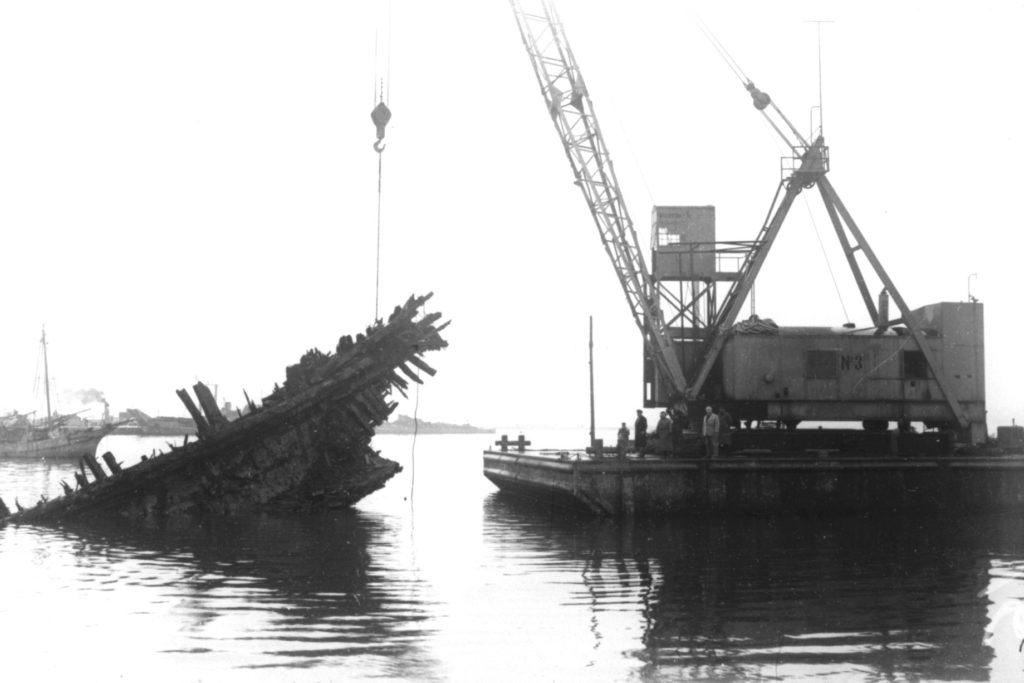
A crane mounted on a floating platform removes debris. Photo courtesy of Volos municipal Center for Historical Research and Documentation (www.diki.gr)
Just thirty minutes into their journey, yet another aircraft reported engine trouble and was forced to return to Brindisi. Only nine aircraft were now left. Incredibly, Flight Commander Shuttleworth also experienced engine trouble by the time they reached the Greek coast. Knowing that his withdrawal would seriously compromise the mission, he decided to press on. Fortunately, the trouble was to eventually resolve itself.
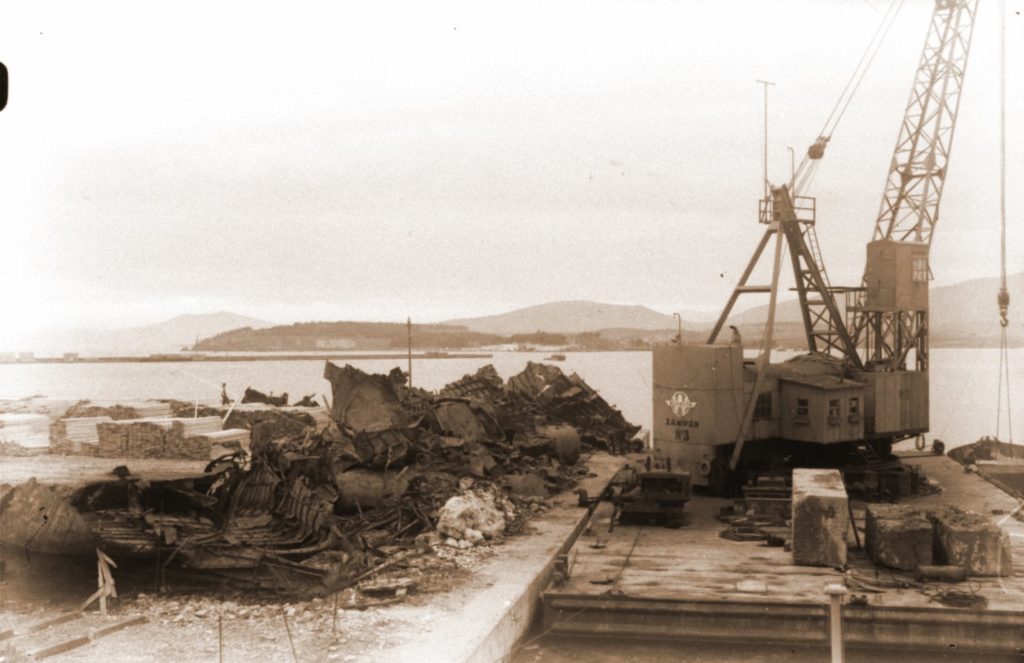
A crane on a floating platform has deposited remains on the quay. The breakwater and Pefkakia can clearly been seen in the background. Photo courtesy of Volos municipal Center for Historical Research and Documentation (www.diki.gr)
Unbeknown to Shuttleworth, more information about the target was coming in. R.A.F. Intelligence Summary No. 226 states that at 10.10 hrs, “Over 70 active vessels were present in the harbour, including the S.S. Adriana (4,353 tons) and S.S. Lola (1,193 tons), 2 War Partenope Destroyers (Italian warships commandeered by the German Kriegsmarine), 2 Corvettes (patrol and convoy warships), 7 Coasters (merchant transport ships) and ‘Danube’ Barges (motorised river transport vessels), 17 Caiques (sailing boats) and nearly 40 small escort vessels of various types.” This very detailed information came “from the field,” meaning that in all likelihood, a Volos citizen had a morse radio and was risking life and limb to spy on the Germans.
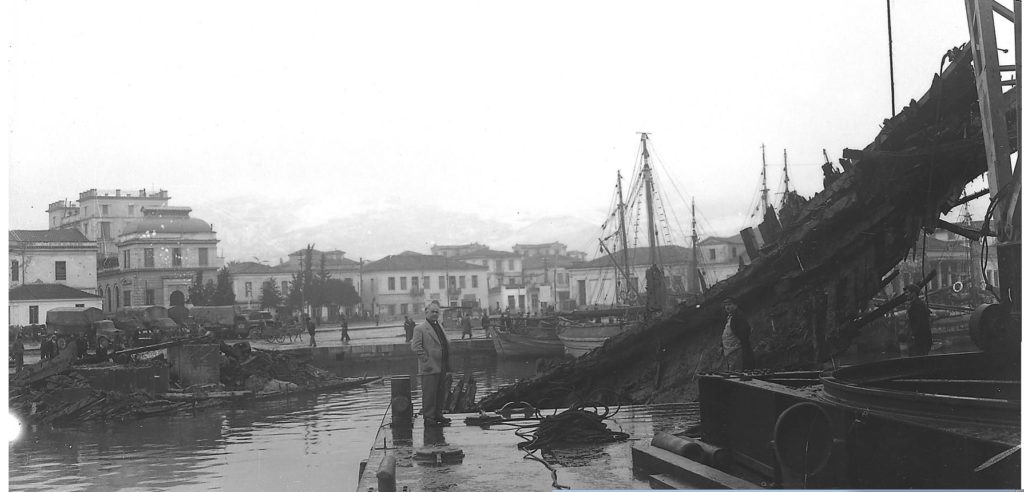
The whole side of a vessel is lifted out of the water. Note the building behind the trucks still exists and is owned by the Volos Municipality. Photo courtesy of Volos municipal Center for Historical Research and Documentation (www.diki.gr)
A few hours later, the flight approached the target in clear skies at 10,000 feet (3,000 m) on a bearing of 40 degrees. They were unaware that the S.S. Lola and the two Destroyers had avoided the impending attack and were steaming towards Thessaloniki.
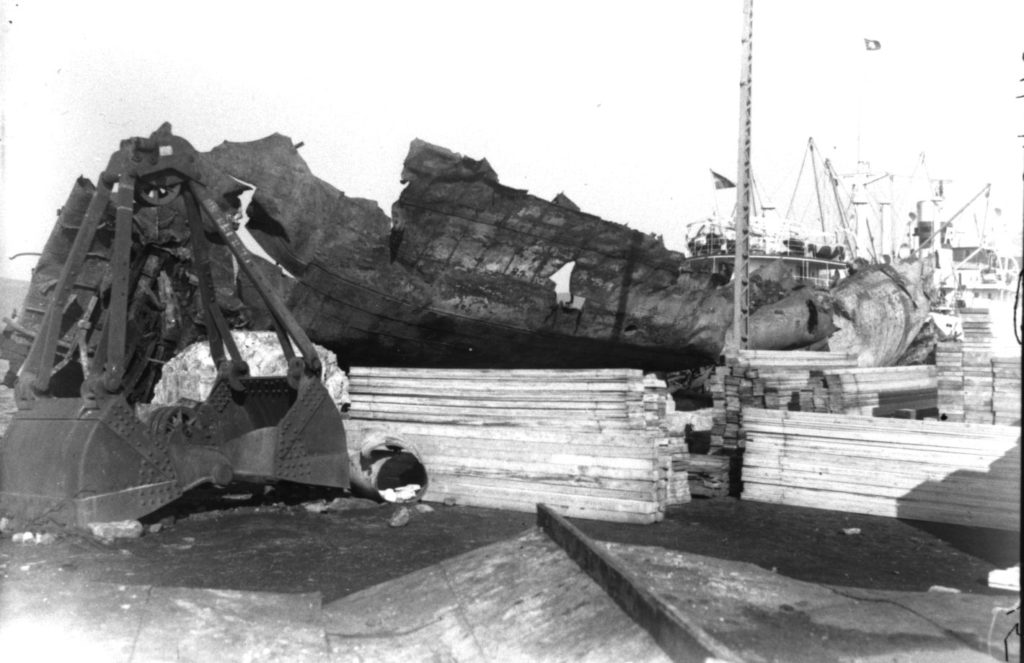
Recovered debris. Note the claw attachment used in the clean-up operations. Photo courtesy of Volos municipal Center for Historical Research and Documentation (www.diki.gr)
Twenty seven 500 lb (220 kg) and thirty six 250 lb (110 kg) high explosive bombs were dropped in rapid succession. As they rained down, the S.S. Adriana, the largest enemy motor vessel in the Aegean area, was set ablaze and began billowing smoke. One of the Corvettes – later identified as the Submarine Chaser UJ-2102 (ex-Brigitte) – was sunk, as too was the ‘Danube’ Barge ‘Laudon’ (378 tons). A host of smaller vessels were also either sunk or destroyed in the firestorm. Even a JU-52 Seaplane was sent straight to the bottom after a direct hit. A huge secondary explosion left a gaping 150 foot (50 m) hole in the quay and damaged “three large blocks of buildings on the quayside.” It had been caused by an ammunition dump being ignited by the mayhem. Other explosions were reported to continue for over ten minutes after the attack.

After being hit on 13.10.44, the S.S.Andrianna burnt for days. Incredibly, she was re-floated on 16.06.47, as this picture testifies. Source: O.A.N. (the Greek Wreck Lifting Organisation) Archives
The material damage was substantial. No one knows how many German casualties there were. In return, the raiders had faced “intense” light and “scant” heavy anti-aircraft fire from warships and ground positions. However, not a single aircraft was hit. As they headed for home, it was noted that plumes of black smoke from the destruction they had wrought could be seen 60 miles (100 km) away.
The flight reached Brindisi at 14:15 hrs and safely returned to Biferno at 16.22 hrs. Photo reconnaissance made the following day confirmed that the raid had been highly effective, despite the depletion in the number of participating aircraft due to mechanical failure. Bombing runs during WWII were notoriously inaccurate. However, the 25th Squadron had been surgical. The town had been spared the possibility of major destruction. In a message of congratulations sent to the S.A.A.F. shortly afterwards, the Air Officer Commanding described the action as an “an excellent performance.”
The archives also report another operation on the 13th, this time by a detachment from the 6th Squadron of the R.A.F.. At 07.45, four Hurricane IV’s commanded by Squadron Leader R.H. Langdon-Davies took off from the recently captured airfield at Araxos, just outside Patra. This reconnaissance mission reached Volos hours before the S.A.A.F. bombing, but failed to be an unintended forewarning for the Germans. A lot of shipping in the harbour was observed, including “one large merchantman with steam up.” Although it remains unconfirmed, this could very well have been the S.S. Lola preparing to leave for Thessaloniki. On the way back, they saw a stationary convoy of around 50 motorised transport vehicles near Thiva. They also reported another convoy of 30 motorised transport vehicles on the Thiva to Lamia road. These fleeing Germans stopped when they were spotted. Inexplicably, someone from the lead vehicle fired a red flare at the passing aircraft.
Despite the S.A.A.F.’s resounding success, the 25th Squadron conducted Operation 58 just three days later, on the 16th. Notwithstanding cloud interference, one of the eight Venturas sent on the raid scored a direct hit on a 1,000 ton ship, setting it on fire. Further hits near the quay where the Hellenic Coast Guard building stands today and the railway jetty to the north destroyed “at least 2 of the 6 to 8 vessels moored alongside.” The overall damage this time, however, was far less. The Germans had learnt from their mistake and had dispersed whatever viable shipping which remained from the previous raid outside the harbour. R.A.F. Intelligence reported that the S.S. Adriana was “listing heavily to starboard and still on fire.” They confirm that she had been carrying troops and heavy equipment from the Athens area.

A wide view of the destruction wrought on some of the smaller vessels. Photo courtesy of Volos municipal Center for Historical Research and Documentation (www.diki.gr)
Volos was again visited on the 17th, but this time by the 809th Squadron of the Air Fleet Arm (i.e. the R.A.F. attached to the Royal Navy). Two flights of Supermarine Seafires (a naval adaptation of the Spitfire) were launched from the aircraft carrier H.M.S. Hunter. Having sailed from Alexandria, Egypt she was now in the Aegean as part of Operation Manna (the liberation of Greece). They attacked Volos harbour, sinking a Dornier Do-24 (a three engined German Flying Boat).
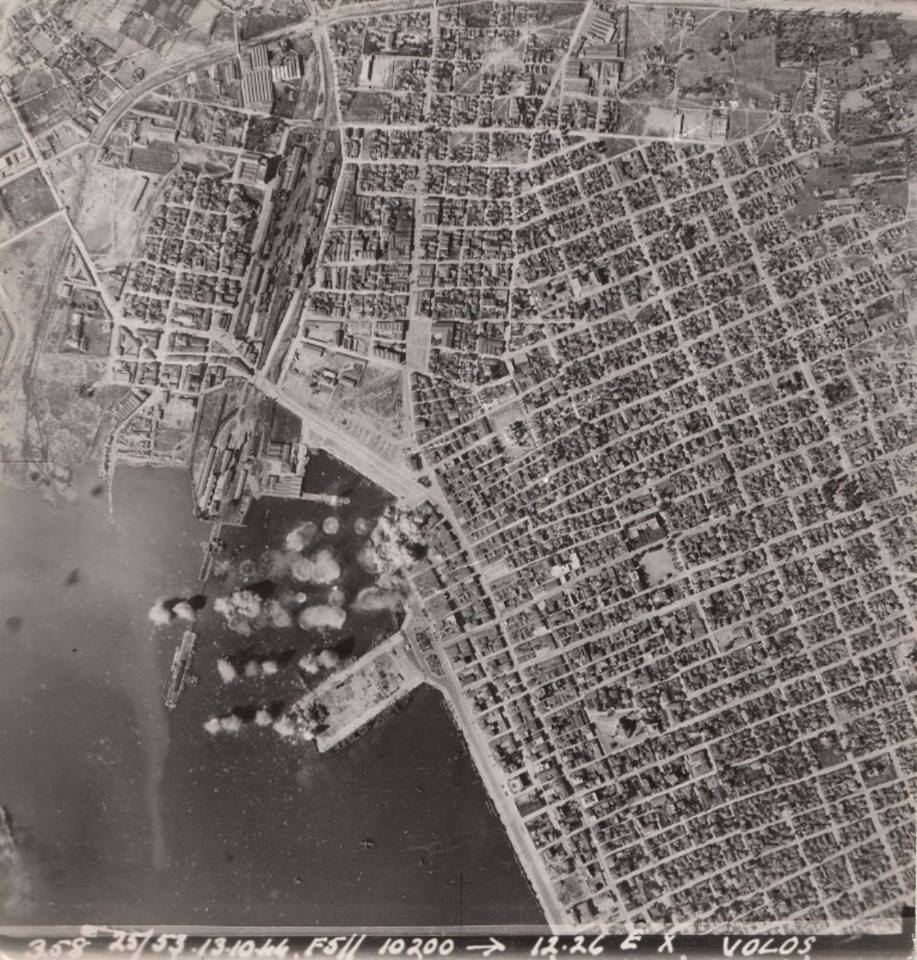
An aerial photograph taken from 10,000 on 13.10.44 during the raid. Careful examination reveals a German JU-52 Seaplane and the shadows of the Ventura bombers themselves. Photo courtesy of Tinus le Roux
On the 22nd, a single R.A.F. Spitfire VB piloted by Flight Officer J.S. Anderson of the 94th Squadron flew over Volos at 1,000 ft (300 m) on a reconnaissance mission. He reported a 1,000 ton ship “with her stern to the quayside.” That was followed the next day by a single R.A.F. Supermarine Spitfire VIII from the 32nd Squadron. It had taken off from the recently acquired Kalamaki airfield in Athens to reconnoitre the Pagasetic Gulf and the area around Volos. A derelict ship was sighted off Almiros bay. Among the many sunken vessels, the same 1,000 ton ship was observed in Volos harbour. To the north west, no convoys on the road from Volos to Larissa were seen. All bridges on the road were reported to be blown up and the railway track destroyed in several places.
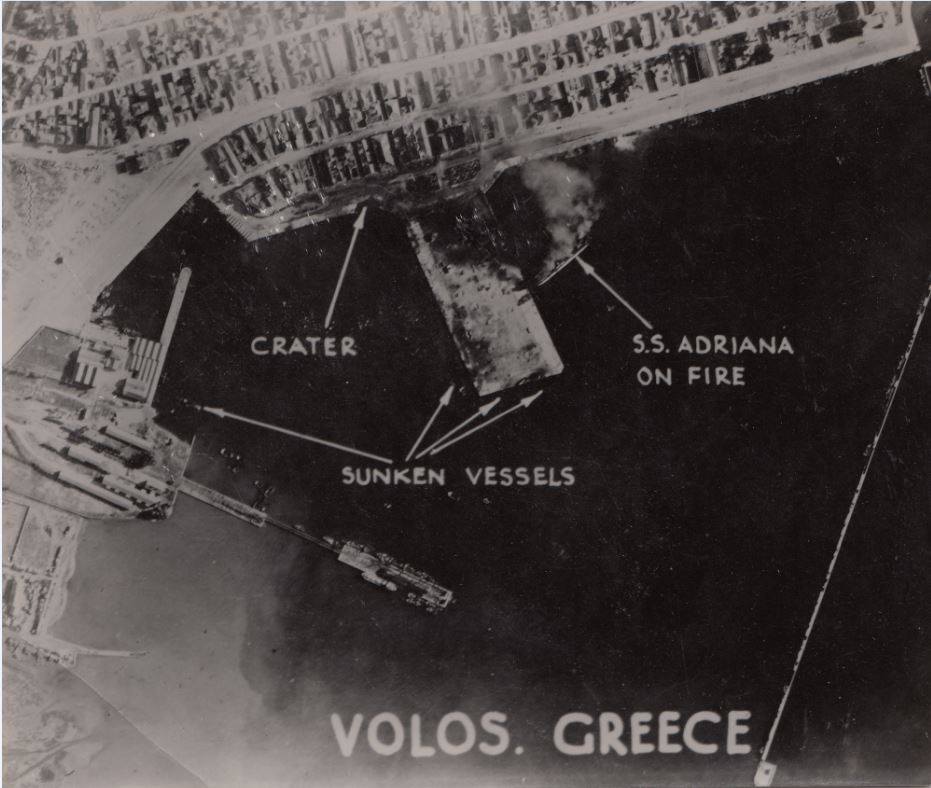
An aerial reconnaissance photograph indicating the damage done on 13.10.44. Note the crater caused after munitions exploded during the raid. Source: Unknown
Even before these last missions, the focus of attention had shifted away from Volos and to the north as the Allies hounded and harassed their enemy’s withdrawal. It turned out that the Germans could retreat just as fast as they had arrived. By the end of October, they were out of the mainland altogether, with only Crete and isolated islands remaining occupied but cut-off. To its great fortune, the township of Volos had physically survived the liberation unscathed. The human toll in terms of horrendous suffering and lives ruined or lost is another matter entirely.
As for the numerous wrecks left littering the harbour, they would eventually be removed and salvaged for scrap. It is, however, an intriguing notion that twisted metal pieces and other remnants of the attacks, including the shattered parts from both Seaplanes, must still lie at the bottom. Perhaps fragments of the very bombs that caused the destruction also remain. Covered by silt and hidden under water, these artefacts have become very much like the memory of this major event in local history; both are largely forgotten as they slowly erode away with time.
[*] Ross J. Robertson researches the official wartime archives to reveal more about the Allied bombing of the Volos harbour during WWII.
